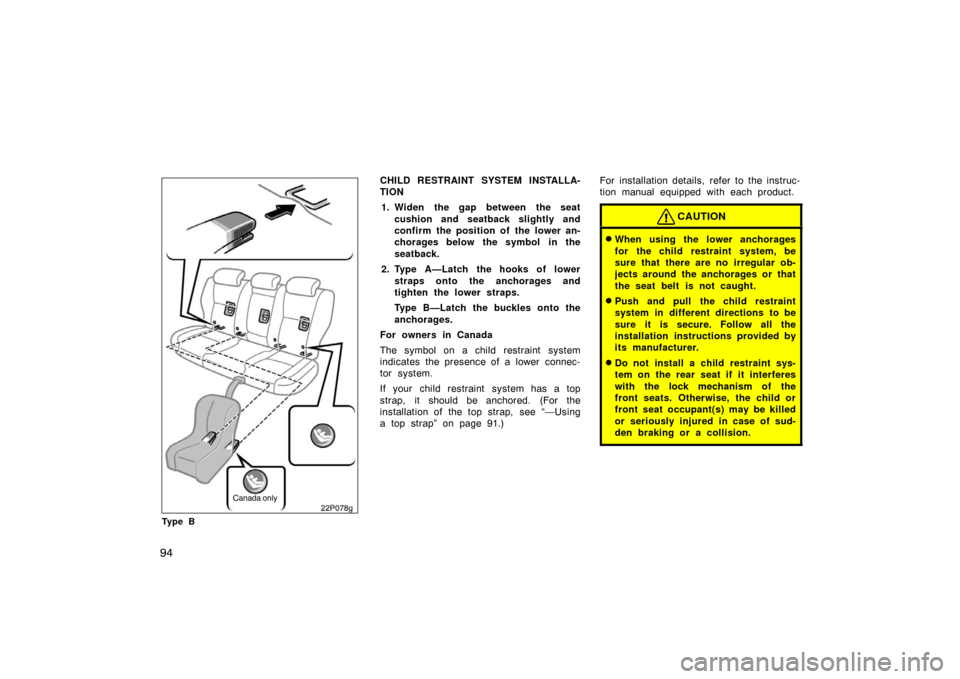Page 92 of 336
92
22p063b
TO USE THE ANCHOR BRACKET:1. Remove the luggage cover (see “Luggage cover” on page 200.) and
raise the head restraint to the upper-
most lock position.
22p215
2. Open the cover of the anchor brack-et.
22p064d
3. Fix the child restraint system withthe seat belt.
Latch the hook onto the anchor
bracket and tighten the top strap.
For instructions to install the child re-
straint system, see “Child restraint” on
page 79.
Page 93 of 336
93
CAUTION
Make sure the top strap is securely
latched, and check that the child re-
straint system is secure by pushing
and pulling it in different directions.
Follow all the installation instructions
provided by its manufacturer.
22p076e
The lower anchorages for the child re-
straint system interfaced with the
FMVSS225 or CMVSS210.2 specification
are installed in the rear seat.
The anchorages are installed in the clear-
ance between the seat cushion and seat-
back of both outside rear seats.
Child restraint system interfaced with the
FMVSS213 or CMVSS213 specification
can be fixed with these anchorages. In
this case, it is not necessary to fix the
child restraint system with a seat belt on
the vehicle.22p077g
Canada only
Ty p e A
—Installation with child
restraint lower anchorages
Page 94 of 336

94
22p078g
Canada only
Ty p e B
CHILD RESTRAINT SYSTEM INSTALLA-
TION1. Widen the gap between the seat cushion and seatback slightly and
confirm the position of the lower an-
chorages below the symbol in the
seatback.
2. Type A—Latch the hooks of lower straps onto the anchorages and
tighten the lower straps.
Type B—Latch the buckles onto the
anchorages.
For owners in Canada
The symbol on a child restraint system
indicates the presence of a lower connec-
tor system.
If your child restraint system has a top
strap, it should be anchored. (For the
installation of the top strap, see “—Using
a top strap” on page 91.) For installation details, refer to the instruc-
tion manual equipped with each product.
CAUTION
�When using the lower anchorages
for the child restraint system, be
sure that there are no irregular ob-
jects around the anchorages or that
the seat belt is not caught.
�Push and pull the child restraint
system in different directions to be
sure it is secure. Follow all the
installation instructions provided by
its manufacturer.
�Do not install a child restraint sys-
tem on the rear seat if it interferes
with the lock mechanism of the
front seats. Otherwise, the child or
front seat occupant(s) may be killed
or seriously injured in case of sud-
den braking or a collision.
Page 323 of 336

323
Occupant restraint sys-tems
Toyota encourages you and your
family to take the time to read
Section 2−2 of this Owner’s Manu-
al carefully. In terms of helping
you understand how you can re-
ceive the maximum benefit of the
occupant restraint systems this ve-
hicle provides, Section 2 −2 of this
Owner ’s Manual is the most im-
portant section for you and your
family to read.
Section 2 −2 describes the function
and operation concerning seats,
seat belts, SRS airbags and child
restraint systems of this vehicle
and some potential hazards you
should be aware of. These sys-
tems work together along with the
overall structure of this vehicle in
order to provide occupant restraint
in the event of a crash. The effect
of each system is enhanced when
it is used properly and together
with other systems. No single oc-
cupant restraint system can, by it-
self, provide you or your family
with the equal level of restraint
which these systems can provide
when used together. That is why it
is important for you and your fam-
ily to understand the purpose and
proper use of each of these sys-
tems and how they relate to each
other.
The purpose of all occupant re-
straint systems is to help reduce
the possibility of death or serious
injury in the event of a collision.
None of these systems, either in-
dividually or together, can ensure
that there is no injury in the event
of collision. However, the more
you know about these systems
and how to use them properly, the
greater your chances become of
surviving an accident without death
or serious injury.
Seat belts provide the primary re-
straint to all occupants of the ve-
hicle, and every occupant of the
vehicle should wear seat belts
properly at all times. Children
should always be secured in child
restraint systems that are ap-
propriate for their age and size.
SRS (Supplemental Restraint Sys-
tem) airbags are, as their names
imply, designed to work with, and
be supplemental to, seat belts and
are not substitutes for them. SRS
airbags can be very effective in
reducing the risk of head and
chest injuries by preventing con-
tact of the head and chest with
interior portions of the vehicle.